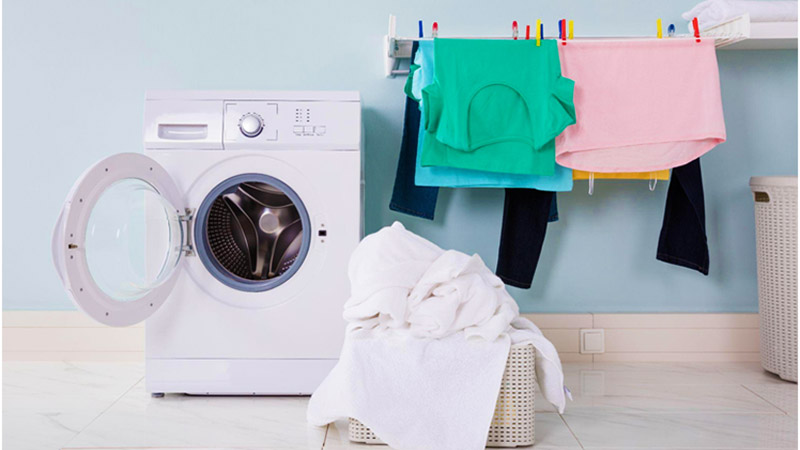Machine Drying vs. Air Drying: Tips to Properly Dry Your Clothes
Drying our clothes is something that all of us do but few of us give a whole lot of thought to. We simply use whatever we’ve been using since we first started doing our own laundry and call it a day. Sometimes, we take special measures because of the garment’s washing instructions. Most of the time, though, we just do what we are used to doing. For some of us, that means throwing our wet laundry in the dryer. For others, it means hanging each individual piece up to dry naturally. We all probably have an idea of which method we think is best, but in the discussion of machine drying vs. air drying, which technique truly reigns supreme?

Image Source: Brian A Jackson/ shutterstock.com
There are undeniable benefits and drawbacks associated with each clothes drying method. Keep reading to learn more about the pros and cons of each option and discover a few tips on how to properly dry your clothes.
Pros and Cons of Machine Drying
Time is a huge factor in the debate between machine and air drying clothing. When you put your clothes in a dryer, they’re usually ready to be worn in an hour or less. Drying clothes on a rack or clothesline takes significantly more time. Keep in mind, too, that using a dryer can save you time by eliminating the need to iron since the heat removes most of the wrinkles.
There are a few drawbacks, though. For starters, machine drying is much harder on your clothes than air drying. You have to be especially careful when drying certain materials–such as wool–to avoid damage. Some garments can’t be machine dried for this reason. Dryers are also expensive, and using them drives up your energy bills. They’re worse for the environment than air drying, too.
Pros and Cons of Air Drying
One of the biggest downsides of air drying your clothes is, of course, that it takes longer than using a dryer. There are still plenty of benefits, though. For starters, clothes that are exclusively air-dried tend to last longer than those that get tossed in the dryer. If you want to keep your favorite sweatshirt soft, drying it in the light of the sun ensures that the fibers won’t get damaged and that the shirt won’t lose its shape. Also, once you have a clothesline or a drying rack, air drying is completely free.
For some people, air drying is not a viable option because they have nowhere to do so. Clotheslines and racks take up a considerable amount of space, and there simply is no room for them in many homes. Keep in mind, too, that some experts advise against air drying clothing indoors because doing so increases humidity and can facilitate the growth of mold. Lastly, you need to have nice weather if you plan on drying your clothes outside. If you live in an area where it rains frequently, air drying might not work well for it. It can also be a challenge during the winter months.

Image Source: Andrey_Popov/ shutterstock.com
Which Is Best?
In terms of convenience, machine drying is the clear winner. When it comes to protecting your clothes from damage and caring for the environment, though, air drying is the best option. Ultimately, it is up to you to weigh the pros and cons to determine which one is best for your home and family.
Tips for Drying Clothes
Whichever option you prefer for drying your clothes, there are right ways and wrong ways to get the job done. If you are planning on using a dryer, make sure to sort your laundry by weight and fiber content. Garments made with heavier fabrics–such as jeans and hooded sweatshirts–tend to take longer to dry than those made from lighter materials, like t-shirts. If you wash heavy and light clothing together, the lightweight garments will end up in the dryer much longer than necessary. The heavier ones can also cause damage.
You also want to avoid overloading the dryer. Doing so could damage your clothes or the dryer. It will also likely take longer for your clothes to dry and they will probably come out wrinkled.
If you typically throw all of your wet clothes in the dryer and set it to high heat, you might want to think twice. Different types of fabrics require different heat levels, and using a temperature that’s too high can cause serious damage. In general, high heat should only be used for things made from heavy fabrics, like sweatshirts, jeans and towels. Medium heat should be used for synthetics and low heat should be used for lingerie, workout gear and other delicate items. If you are just refreshing clothes that are already dry, use a no-heat tumble setting.
When air drying clothes, be sure to keep them separated to allow for adequate airflow. Sweaters and other garments that can easily be stretched out of shape should be laid flat on racks rather than hung up. When air drying clothing inside your home, be sure to do so in a well-ventilated area. Alternatively, use a dehumidifier to prevent excess moisture from facilitating mold growth inside your home.
The Bottom Line
When it comes to drying your clothes, the debate between machine drying and air drying largely comes down to personal preference. Each option has its own drawbacks and benefits, so choose whichever one works best for your family. Of course, you can also use both methods depending on the season and weather and what type of garments you are washing. Whatever option you prefer, be sure to take steps to dry your clothes properly to avoid damaging them. By properly caring for your clothes when drying them, you can extend their life and, if you are using a dryer, extend the life of your appliance.


